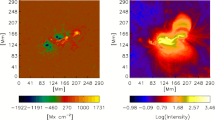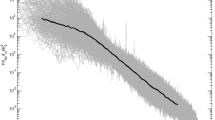Abstract
Ground-based (Big Bear Solar Observatory) and extra-atmospheric (SOHO/MDI) measurements of the photospheric line-of-sight magnetic field of one active and two quiet regions are used to calculate power spectra of the field, taking into account the characteristic function for the diffraction limit of the telescope resolution. At high frequencies, the physically meaningful linear interval in the spectrum extends to a wave number of k=4.6 Mm−1 (spatial scale l=1.4 Mm) for the quiet regions and k=3.35 Mm−1 (l=1.9 Mm) for the active region. A high-frequency spectral break at k≥3 Mm−1 is associated with the characteristic telescope function; the position of the break and the spectral slope beyond the break do not reflect the turbulent state of the field. As the field recording improves, the break shifts toward higher frequencies. The spectral indices in the physically meaningful linear interval are substantially different for the active and quiet regions: in the active region (NOAA 8375), the spectrum behaves as E(k)≈k −1.7 (very close to the Kolmogorov index, −5/3) in the interval 0.78≤k≤3.35 Mm−1, while in the quiet regions E(k)≈k −1.3 for 0.77≤k≤4.57 Mm−1. This difference can be explained by the additional effect of a small-scale turbulent dynamo in the unperturbed photosphere. In this case, this mechanism can generate at least 6% of the magnetic energy of the photospheric line-of-sight field in quiet regions.
Similar content being viewed by others
References
S. I. Vainshtein, Ya. B. Zel'dovich, and A. A. Ruzmaikin, Turbulent Dynamo in Astrophysics (Nauka, Moscow, 1980).
E. Parker, Cosmical Magnetic Fields, Their Origin and TheirActivity (Clarendon, Oxford, 1979).
M. Meneguzzi, U. Frisch, and A. Pouquet, Phys. Rev. Lett. 47, 1060 (1981).
M. Meneguzzi and A. Pouquet, J. Fluid Mech. 205, 297 (1989).
J. O. Stenflo, Astron. Astrophys. Rev. 1, 3 (1989).
S. Saar, in The Sun and Cool Stars: Activity, Magnetism, Dynamos (IAU Coll. 130), Ed. by I. Tuominen, D. Moss, and G. Rudiger (Springer-Verlag, Berlin, 1991), p. 389.
K. Petrovay and G. Szakaly, Astron. Astrophys. 274, 543 (1993).
F. Cattaneo, Astrophys. J. Lett. 515, L39 (1999).
A. N. Kolmogorov, Usp. Fiz. Nauk 93(3), 476 (1967) [Sov. Phys. Usp. 10, 734 (1968)].
A. S. Monin and A. M. Yaglom, Statistical Fluid Mechanics (Nauka, Moscow, 1967; MIT, Cambridge, 1975), Vol. 2.
U. Frisch, Turbulence. The Legacy of A. N. Kolmogorov (Cambridge Univ. Press, Cambridge, 1995).
R. S. Iroshnikov, Astron. Zh. 40, 742 (1963) [Sov. Astron. 7, 566 (1963)].
R. H. Kraichnan, Phys. Fluids 8, 1385 (1965).
B. B. Mandelbrot, The Fractal Geometry of Nature (New York, 1983).
V. Abramenko, V. Yurchyshyn, H. Wang, and P. R. Goode, Sol. Phys. (2001) (in press).
Y. Nakagawa and E. R. Prist, Astrophys. J. 179, 949 (1973).
Y. Nakagawa and R. H. Levine, Astrophys. J. 190, 441 (1974).
E. Knobloch and R. Rosner, Astrophys. J. 247, 300 (1981).
J. W. Lee, J. C. Chae, H. S. Yun, and H. Zirin, Sol. Phys. 171, 269 (1997).
G. M. Jenkins and D. G. Watts, Spectral Analysis and Its Applications (Holden-Day, San Francisco, 1968; Mir, Moscow, 1972), Vol. 2.
Ya. I. Khurgin and V. P. Yakovlev, Compact Functions in Physics and Technical Fields [in Russian] (Nauka, Moscow, 1971).
R. Muller, Solar and Stellar Granulation, Ed. by R. Rutten and G. Severino (Kluwer, Dordrecht, 1989), NATO ASI Ser., Ser. C 263, 101 (1989).
G. Consolini, E. Berrilli, E. Pietropaolo, et al., in Proceedings of the 9th European Meeting on Solar Physics: Magnetic Fields and Solar Processes, Florence, 1999, Eur. Space Agency SP-448, 1, 209 (1999).
D. Y. Chou, B. J. LaBonte, D. C. Braun, and T. L. Duvall, Jr., Astrophys. J. 372, 314 (1991).
O. Espagnet, R. Muller, Th. Roudier, and N. Mein, Astron. Astrophys. 271, 589 (1993).
Th. Roudier, R. Muller, P. Mein, et al., Astron. Astrophys. 248, 245 (1991).
R. E. Gershberg, Astrofizika 22, 531 (1985).
B. Schmieder, M. Rovira, G. M. Simnett, et al., Astron. Astrophys. 308, 957 (1996).
E. N. Parker and A. Thyagaraia, Sol. Phys. 189, 45 (1999).
H. Lin and T. Rimmele, Astrophys. J. 514, 448 (1999).
S. I. Gopasyuk, Kinematika Fiz. Nebesnykh Tel 16(2), 138 (2000).
Author information
Authors and Affiliations
Additional information
__________
Translated from Astronomicheski\(\overset{\lower0.5em\hbox{$\smash{\scriptscriptstyle\smile}$}}{l} \) Zhurnal, Vol. 78, No. 10, 2001, pp. 942–952.
Original Russian Text Copyright © 2001 by Abramenko, Yurchyshyn, Wang, Goode.
Rights and permissions
About this article
Cite this article
Abramenko, V.I., Yurchyshyn, V.B., Wang, H. et al. Parameters of the turbulent magnetic field in the solar photosphere: Power spectrum of the line-of-sight field. Astron. Rep. 45, 824–833 (2001). https://doi.org/10.1134/1.1408983
Received:
Issue Date:
DOI: https://doi.org/10.1134/1.1408983




